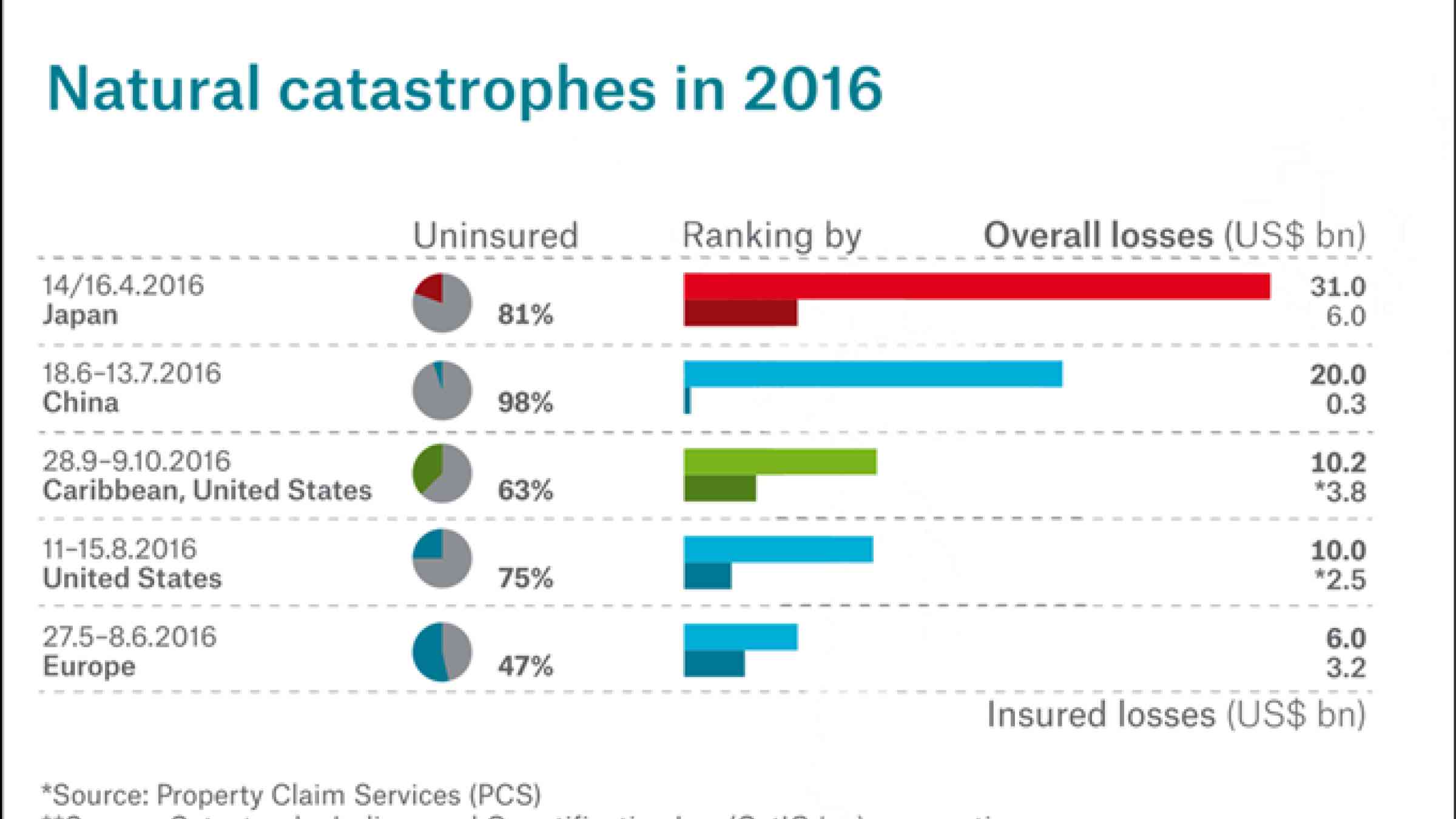Please help us improve PreventionWeb by taking this brief survey. Your input will allow us to better serve the needs of the DRR community.
Natural catastrophe losses at their highest for four years

A number of devastating earthquakes and powerful storms made 2016 the costliest twelve months for natural catastrophe losses in the last four years. Losses totalled US$ 175bn, a good two-thirds more than in the previous year, and very nearly as high as the figure for 2012 (US$ 180bn). The share of uninsured losses – the so-called protection or insurance gap – remained substantial at around 70%. Almost 30% of the losses, some US$ 50bn, were insured.
“After three years of relatively low nat cat losses, the figures for 2016 are back in the mid-range, where they are expected to be. Losses in a single year are obviously random and cannot be seen as a trend”, said member of the Board of Management Torsten Jeworrek. “The high percentage of uninsured losses, especially in emerging markets and developing countries, remains a concern. Greater insurance density is important, as it helps to alleviate the financial consequences of a catastrophe for more people. With its risk knowledge, the insurance industry would in fact be able to bear a much greater portion of such unpredictable risks.”
Key nat cat figures of 2016
- Both overall losses and insured losses were above the inflation-adjusted average for the past ten years (US$ 154bn and 45.1bn respectively).
- Taking very small events out of the equation, 750 relevant loss events such as earthquakes, storms, floods, droughts and heatwaves were recorded in the Munich Re NatCatSERVICE database. That is significantly above the ten-year average of 590.
- Some 8,700 lives were sadly lost as a result of these natural catastrophes, far fewer at least than in 2015 (25,400), yet within the ten-year average (60,600). The past year was thus the year with the fewest fatalities (after 2014, with 8,050 fatalities) in 30 years (1986: 8,600).
- The high number of flood events, including river flooding and flash floods, was exceptional and accounted for 34% of overall losses, compared with an average of 21% over the past ten years.
Earthquake in Japan most expensive natural catastrophe of 2016
The costliest natural catastrophes of the year occurred in Asia. There were two earthquakes on the southern Japanese island of Kyushu close to the city of Kumamoto in April (overall losses US$ 31bn; proportion of insured losses just under 20%), and devastating floods in China in June and July (overall losses US$ 20bn; only some 2% of which were insured).
North America was hit by more loss occurrences in 2016 than in any other year since 1980, with 160 events recorded. The year’s most serious event here was Hurricane Matthew. Its greatest impact was in the Caribbean island nation of Haiti, which was still struggling to recover from the 2010 earthquake. Matthew killed around 550 people in Haiti, and also caused serious damage on the east coast of the USA. Overall losses totalled US$ 10.2bn, with over a third of this figure insured.
Series of storms in Europe, wildfires in Canada
North America was also impacted by other extreme weather hazards, including wildfires in the Canadian town of Fort McMurray in May, and major floods in the southern US states in summer. In Canada, the mild winter with less snow than usual, and the spring heatwaves and droughts which followed, were the principal causes of the devastating wildfires that hit the oil-sand-producing region of Alberta, generating overall losses of US$ 4bn. More than two-thirds of this figure was insured. In August, floods in Louisiana and other US states following persistent rain triggered losses totalling US$ 10bn, around a quarter of which was insured.
There was a series of storms in Europe in late May and early June. Torrential rain triggered numerous flash floods, particularly in Germany, and there was major flooding on the River Seine in and around Paris. Overall losses totalled some US$ 6bn (approximately €5.4bn), around half of which was insured.
“A look at the weather-related catastrophes of 2016 shows the potential effects of unchecked climate change. Of course, individual events themselves can never be attributed directly to climate change. But there are now many indications that certain events – such as persistent weather systems or storms bringing torrential rain and hail – are more likely to occur in certain regions as a result of climate change”, explained Peter Höppe, Head of Munich Re’s Geo Risks Research Unit.
Explore further
Please note: Content is displayed as last posted by a PreventionWeb community member or editor. The views expressed therein are not necessarily those of UNDRR, PreventionWeb, or its sponsors. See our terms of use
Is this page useful?
Yes No Report an issue on this pageThank you. If you have 2 minutes, we would benefit from additional feedback (link opens in a new window).